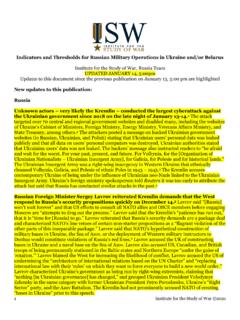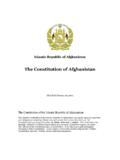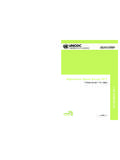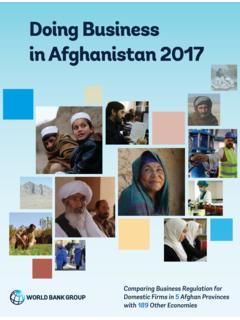Transcription of ISIS IN AFGHANISTAN - Institute for the Study of War
1 3, 2015 isis IN AFGHANISTANBy Harleen GambhirKey Takeaway: The Islamic State of Iraq and al-Sham ( isis ) s affiliate in the AFGHANISTAN -Pakistan region is effective, operational, and positioned to expand. The affiliate, Wilayat Khorasan, controls populated areas in AFGHANISTAN s eastern Nangarhar Province and has launched attacks on Jalalabad and Kabul. AFGHANISTAN s security is deteriorating and will likely worsen. Taliban infighting has intensified after the official announcement in July 2015 that Mullah Omar, the movement s founder, had died several years ago.
2 The leader of the strongest Taliban faction may also have been killed in internal clashes on December 2. These violent conditions will likely facilitate Wilayat Khorasan s recruitment, attacks, and territorial expansion. These violent conditions will likely facilitate Wilayat Khorasan s recruitment, attacks, and territorial expansion. AFGHANISTAN s precarious unity government has not maintained effective security as international forces have drawn down. Wilayat Khorasan s growth gives isis additional strategic resiliency outside of Iraq and Syria and will intensify the global competition between isis and al-Qaeda (AQ), which is also present in the area.
3 The United States and its NATO allies must respond more aggressively to this threat. | isis IN AFGHANISTAN | HARLEEN GAMBHIR| DECEMBER 3, 2015 isis S OBJECTIVES IN AFGHANISTAN AND PAKISTANF ostering an affiliate in AFGHANISTAN and Pakistan serves several of isis s strategic objectives. isis s grand strategic aim is to rule all historically Muslim lands in a caliphate that wins an apocalyptic war with the West. External affiliates support this objective by giving isis strategic resiliency, facilitating its military expansion outside of Iraq and Syria, and legitimizing its claimed status as a trans-regional caliphate.
4 isis likely prioritizes expansion in the greater AFGHANISTAN /Pakistan region (also known as Khorasan) because of the region s historic and religious importance. The modern jihadist movement originated in AFGHANISTAN . Islamic religious texts state that the army of true believers will gather in the Khorasan before the isis requires presence in the region in order to actualize its literal interpretation of apocalyptic scripture. Operations in the AFGHANISTAN -Pakistan border region also enable isis directly to challenge al-Qaeda (AQ), its rival for the leadership of the global jihadist movement.
5 AQ s senior leadership is based in the border region and contests isis s claim to hold political and religious authority over all Muslims. isis IN NANGARHAR: CURRENT SITUATION ON NOVEMBER 20, 2015 isis s Wilayat Khorasan maintains an overt military and social presence in Nangarhar Province in eastern AFGHANISTAN , where it controls numerous villages as of November 20, 2015, specifically in Achin, Deh Bala, Bati Kot, Shinwar, Kot and Chaparhar districts. The geographic spread of isis s control in Nangarhar reflects the organization s intent to control local communities and establish Shari a governance in the greater AFGHANISTAN -Pakistan region.
6 isis may not seek to attack and control district centers in Nangarhar as Taliban factions have elsewhere in AFGHANISTAN . The district centers are generally small and pose few obstacles to freedom of movement because they can be circumvented by road. Instead, isis s next goal in Nangarhar is likely to attack the provincial capital of Jalalabad, particularly and Afghan government forces based in the city. isis also likely aims to control Highway 7 between Jalalabad and Torkham Gate, the border-crossing to Pakistan, in order to tax goods transported on this main artery.
7 isis has also demonstrated its intent to attack | isis IN AFGHANISTAN | HARLEEN GAMBHIR| DECEMBER 3, 2015 Kabul, roughly 150 kilometers away from Jalalabad. isis already has claimed multiple explosive attacks in and near Jalalabad and one attack in Kabul since September map below depicts isis s assessed control, attack, and support zones in Nangarhar province as of November 20, 2015. Control military doctrine defines control as physical or psychological pressure to assure that individuals or groups within the area respond as directed.
8 3 Control also requires a military commander to maintain physical influence over a specified area to prevent its use by an enemy. A control zone therefore refers to an area where an actor maintains capacity to repel opposing forces from that location, and often where that actor can govern or compel population behavior. The control zones on this map mark locations where isis has taken over local mosques, executed locals, forced residents into marriage, administered schools and prisons, closed health care centers, or exhibited other indicators of dominance over the local population according to open source reporting.
9 isis has faced armed resistance in some of its control zones in southern Nangarhar. isis battled the Taliban while expanding social control between March and July 2015, and clashed with the Afghan National Security Forces (ANSF) from September 2015 onward. The Afghan government in November 2015 has been supporting locals seeking to expel isis from Achin The result of these efforts is unclear, as isis retains the ability to attack security and civilian sites in Zone military doctrine defines an attack zone as an area where a unit conducts offensive maneuver.
10 6 isis initially launched offensive operations against the Taliban rather than the ANSF in Nangarhar, suggesting that the Taliban posed a greater threat to isis s control of terrain than the government. The ANSF did not challenge isis s expansion into Nangarhar for several months, reflecting the weakness of government forces in the province. isis has launched attacks in Nangarhar s southern and western districts since April 2015, specifically in Achin, Jalalabad, Deh Bala, Pachieragam, Chaparhar, Sherzad, and Surkhrod districts. These include attacks on Taliban, ANSF, government, and international targets.
















